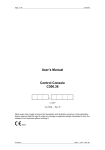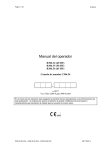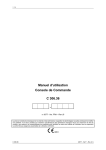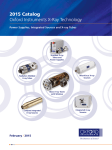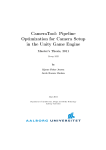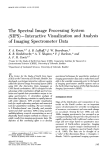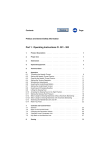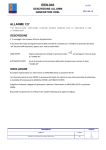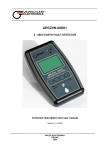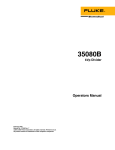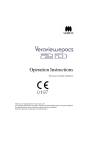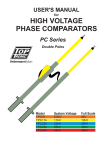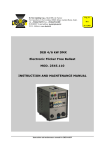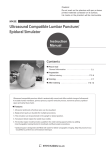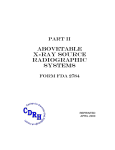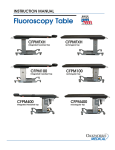Download User`s manual
Transcript
User’s manual Control Panel C306.40, C306.41 n. 0078 Ver. ENG Rev K13 While every care is taken to ensure the description and illustration accuracy in this publication, factory reserves itself the right to make any change in equipment design considered being in the interest of its customers without notice it. NOTICE The safety of both patient and operator was a major consideration in the design and manufacturing of this equipment. The equipment will function reliably when operated, maintained, and repaired according to the instructions in this manual. Misuse, however, could result in hazards to patient, operator and/or equipment. CONFORMITY CERTIFICATION Manufacturer certifies that X-ray generator series R306.3x - R306.4x is in accordance to European Medical Directive MDD 93/42, and it meets all the requirement asked by tubes or subassemblies that complies with this regulation, only if controls and requirement are strictly observed and tubes calibrated in the working range specified by tube. X-RAY DIAGNOSTIC SYSTEMS MECHANICAL and ELECTRICAL SAFETY All moveable assemblies and parts of the unit should be carefully operated and routinely inspected according to the Operator and Maintenance Manuals. Only properly trained and qualified people should have access to any internal components; before opening any access door be sure that line disconnect witch is open. DO NOT REMOVE the high voltage cables from the X-ray tube housing or high voltage generator until main and auxiliary power supplies have been disconnected. Failure to comply with the above may result in hazard to operator, patient, and/or equipment. Electrical Grounding Instruction Equipment when installed must comply IEC 601-2-7 grounding requirements, it must have a protection ground using a specific separate ground cable. The neutral side of the line is not to be considered the heart ground. DIAGNOSTIC X-RAY DEVICES IONIZING RADIATION WARNING Ionizing radiation can be dangerous for both the patient and the operator if safety regulation is omitted. Only specifically trained people can operate ionizing radiation equipments, following the on-site radiation directive according to general safety rules. Summary 1 GENERALS 1 1.1 Introduction..........................................................................................................................1 1.2 Technical Characteristics .....................................................................................................1 1.3 Configuration .......................................................................................................................1 1.3.1 User’s Interface .................................................................................................................2 1.4 Programmed Memory ..........................................................................................................2 1.5 Patient Oriented Anatomic Selection...................................................................................2 1.6 User selection – Free Technique..........................................................................................3 1.7 Automatic Exposure Control Technique..............................................................................3 1.8 Working Place Selection......................................................................................................3 2 Controls 4 2.1 Generator Switch ON/OFF ..................................................................................................4 2.1.1 Control Electronics Switch ON.........................................................................................4 2.1.2 Power Electronics Switch ON...........................................................................................4 2.1.3 Generator Switch OFF ......................................................................................................4 2.1.4 Reload Installation Condition ...........................................................................................4 2.2 User Panel – Main Screen....................................................................................................5 2.3 Generator Status...................................................................................................................6 2.4 Ionizing Radiation Emission Indication...............................................................................7 2.5 Warning Message.................................................................................................................8 2.6 Alarm Messages.................................................................................................................10 2.7 Working Stations (Accessories Selection).........................................................................17 3 Intermittent Mode 21 3.1 Radiographic Techniques...................................................................................................21 3.1.1 3 Points Technique..........................................................................................................21 3.1.2 2 Points Technique..........................................................................................................22 3.1.3 Automatic Exposure Control Technique.........................................................................23 3.2 Focal Spot Selection...........................................................................................................24 3.3 Automatic Exposure Control Option .................................................................................25 3.3.1 AEC controls...................................................................................................................25 3.4 Last Exposure Data Summary Window.............................................................................26 4 Intermittent Mode Data Programming 29 4.1 Programmed Memory Selection ........................................................................................29 4.1.1 APR Program Selection ..................................................................................................29 4.1.2 Programming Utilities.....................................................................................................30 4.2 Programmed Anatomic Selection ......................................................................................33 4.2.1 Patient Size oriented Program Selection .........................................................................33 4.2.2 Programming Utilities.....................................................................................................35 4.2.3 Organ/Thickness oriented Program Selection.................................................................37 4.2.4 Programming Utilities.....................................................................................................38 5 Continuous Mode (RF) 43 5.1 Continuous Fluoroscopy ....................................................................................................43 5.1.1 Automatic / Manual ........................................................................................................43 5.1.2 Chained parameters.........................................................................................................44 5.1.3 Free parameters ...............................................................................................................44 5.2 Intermittent Fluoroscopy....................................................................................................45 5.3 High Contrast Fluoroscopy* ..............................................................................................45 5.3.1 Automatic / Manual ........................................................................................................46 5.3.2 Pulse rate .........................................................................................................................46 5.4 Fluoroscopy data visualization...........................................................................................47 5.5 Zero Points Technique .......................................................................................................47 5.6 Fluoroscopy back-up Timer ...............................................................................................47 6 6.1 6.2 6.3 6.4 Cine Sequence Mode 49 Sequence maximum Runtime ............................................................................................49 Automatic adjustment ........................................................................................................51 Frame Cadence...................................................................................................................51 Zero Point technique ..........................................................................................................51 7 Digital System Drivers 52 7.1.1 Generic ............................................................................................................................52 7.1.2 Infimed ............................................................................................................................52 7.1.3 X-Sight ............................................................................................................................52 7.1.4 ATS - Hiris......................................................................................................................52 7.1.5 Ibis...................................................................................................................................53 7.1.6 Alpha Technologies ........................................................................................................53 7.1.7 Nical “DFI” .....................................................................................................................53 8 CONTROL CONSOLE OPTION 54 8.1 LANGUAGE SELECTION...............................................................................................54 8.2 INITIAL SETUP CONDITION RELOAD .......................................................................54 8.3 ANATOMIC TECHNIQUE SELECTION .......................................................................54 8.4 INITIAL MESSAGE ACCEPTANCE MODE .................................................................57 8.5 CUSTOMER LOGO VISIBILITY....................................................................................57 8.6 APR ICON from software revision 1.04b onwards ...........................................................57 9 SAFETY NOTICE 58 9.1 General Information...........................................................................................................58 9.2 Safety .................................................................................................................................59 9.2.1 Safety against Explosion .................................................................................................59 9.2.2 Safety against ionizing radiation.....................................................................................59 9.2.3 Automated Procedures and Device periodic test ............................................................59 9.2.4 Cleaning ..........................................................................................................................60 9.3 Performance and Safety Tests............................................................................................60 9.3.1 Daily Tests ......................................................................................................................60 9.3.2 Monthly Tests .................................................................................................................60 9.3.3 Annual Service ................................................................................................................60 10 APPENDIX 62 10.1 Styles..................................................................................................................................62 10.2 Languages ..........................................................................................................................63 10.3 Dialer/Selector ...................................................................................................................63 10.4 Data Summary....................................................................................................................65 1 GENERALS 1.1 Introduction R306.3x and R306.4x microprocessors controlled series of X-Ray Generator have been developed according to conventional radio-diagnostics needs. Repetitive operations have been reduced using a new concept of intuitive Anatomical Programming Techniques. Designers always take in consideration the easy and intuitive interaction between man and device during the development process of these products All X-ray parameters are freely changeable, and can be user-stored in memory associated with strings of characters freely selectable for quick retrieve. 1.2 Technical Characteristics R306.3x and R306.4x microprocessors controlled series of X-ray generator series includes several versions of high frequency generators; the common characteristics are listed below. • Microprocessors controlled, network connected modular units. • Intuitive Anatomic programming. • R306.3x power output 40 - 50 - 65 - 80kW (High frequency - High Voltage Rectification). • R306.4x 3x power output 50 - 65 – 80-100kW (High frequency - High Voltage Rectification). • Automatic Mains Voltage Drop Compensation. • Intermittent working modes: o Automatic Exposure Control; o Anatomical (APR) including Automatic Exposure Control; o Free technique, including Automatic Exposure Control. • Easy and Intuitive parameters change. • Touch View interface (Touch Screen panel). • 1,2,3 points techniques. • X-Ray Time & mAs pre-indication in kV/mA/s technique. • Actual Exposure Time display in Automatic Exposure Control mode (1 or 2 points). • Tube thermal load indication in Relative and Absolute format . 1.3 Configuration R306.3x and R306.4x microprocessors controlled series of X-Ray Generator always includes the Power Rack (H.V. Transformer, Power Electronics and Control Electronics), and, as option, a Touch Screen Control Consol for User Interaction. 0078 Ver ENG Rev K7 page 1 1.3.1 User’s Interface User’s Interface is realized using a Graphic Interface on a small Touch Screen industrial class computer. All the information and selections are made through graphic virtual Selectors and Graphic Displays on the control console. The Control Panel permits all the working techniques (1-2-3 points) as well as the technique using Automatic Exposure Control and prefixed anatomical programs. The Control Console is connected to the microprocessor located in the power rack via Controlled Area Network Bus over a cable carrying all the necessary machine status information. All the functions are controlled via the various microprocessors standing on the network during all the working phases, the operator is instantaneously informed of the “machine status” in progress using icons and color lights. 1.4 Programmed Memory The term “Program” stands for an series of values stored in a computer location in which it is described the way the generator have to be set for the specific job. Every program is associated with two 12 characters strings for easy user recall. In every program are stored all the useful parameters such as kV, mA, time, working stations, predisposition for AEC, X- Ray tube, continuous mode preset and so further. These values can be adapted to three patient sizes according to its structure (normal, thin, obese) using the proper control. At any time, the pre-programmed parameters can be corrected on the control console according to the operator decisions. The programs available are as follows: • 8 Programs per screen; • 3 banks per working station: 24 programs per working station; • 5 working station on R306.4x or 4 working station on R306.3x. For a total of 120-memory location on 3 patients: 360 programmable working ways. 1.5 Patient Oriented Anatomic Selection The term ”Anatomic Program” is a memorized series of value associated to two strings of six characters each standing for Organ name and Exposure Projection. When a program is selected, the generator automatically sets according to the memorized values including Working Station, X-Ray technique, Selected tube, Fluoroscopy mode, … These values can be adapted to three patient sizes according to its structure (normal, thin, obese) using the proper control. An alternative is selecting the organ and the measured patient thickness expressed in millimeters. At any time, the pre-programmed parameters can be corrected on the control console according to the operator decisions. The programs available are as follows: page 2 0078 Ver ENG Rev K7 8 Anatomic levels; 3 memory banks per Anatomic Level; 6 Organ/Projections combination per memory bank. Every parameter is user assignable over 144 Organ/Projections combination assignable to 3 patients size for a total of 432 programmable locations. Using the thickness technique, infinite virtual combination is available. 1.6 User selection – Free Technique Every single modification of a programmed value changes the generator status to “Free Technique”: the starting values are the ones memorized in an anatomic program, freely changeable. 1.7 Automatic Exposure Control Technique Automatic exposure control chamber is automatically chosen when the associated working station is selected. Up to three dominant zones are freely selectable. Up to three different film/screen combinations (Slow Speed High Resolution, Normal Speed Medium Resolution, High Speed Low Resolution, for example). The Automatic Exposure calibration process is performed by technical service during generator installation the calibrated darkness can be modified by user needs in seven different timing steps from 50% to 200% of the nominal timing value. A user selectable mAs limit can be runtime selectable for special regulation requirements. Exposure technique (1 or 2 points) is set during generator installation according to user’s specifications. 1.8 Working Place Selection In Anatomic technique, the working station is automatically set according to the exam selected. In free Technique or in Programmed technique, the working station is selected according to the user working way through on-keyboard virtual pushbuttons. 0078 Ver ENG Rev K7 page 3 2 Controls 2.1 Generator Switch ON/OFF 2.1.1 Control Electronics Switch ON Press I key on control console to switch on the control electronics. A welcome message will appear on the control console screen. 2.1.2 Power Electronics Switch ON Switch on the Generator and the Power Electronics on welcome screen, pressing pushbutton. Since the power part is switched on it is possible to modify the parameters and recall a stored program. 2.1.3 Generator Switch OFF Press o key on control console to switch off the generator. Immediately is switched off the power electronics, after a few seconds it is switched off also the control electronics including the control console. 2.1.4 Reload Installation Condition page 4 0078 Ver ENG Rev K7 If on starting screen (the welcome dialog box) appears the following key and doesn’t appear key the generator has lost the actual configuration. the It is possible to reload the initial configuration by pressing Than key. key appears and has to be pressed to start the electronics and go on working. If it happens call your Local Technical Service to inspect the causes of this configuration lost. key appears within key, the generator in Initial Setup Condition: call your Local If the Technical Service to switch the generator in Normal Working Condition before using it. 2.2 User Panel – Main Screen Several virtual gauges are present on the main screen: GENERAL GENERATOR STATUS ICON WORKING STATIONS ANATOMIC SELECTION in alternative to Programmed Selection PROGRAMMED SELECTION in alternative to Anatomic Selection INTERMITTENT MODE RADIOGRAPHY TECHNIQUE SELECTOR RADIOGRAPHIC PARAMETERS AUTOMATIC EXPOSURE CONTROL CINE RADIOGRAPHY 0078 Ver ENG Rev K7 page 5 CONTINUOUS MODE FLUOROSCOPIC TECHNIQUE SELECTOR FLUOROSCOPIC PARAMETERS 2.3 Generator Status Generator status is identified with several icons the GENERATOR STATUS ICON display: HANDSHAKE STAND-BY RADIOGRAPHIC EXPOSURE REQUEST READY FOR EMISSION Initial link try-out between control console and power rack Parameters modify status Pressing the I Step discrete key on the control console or an optional hand switch the generator changes status from STANDBY to this state When the II Step key is pressed within the I Step key pressed the new state is this. Now the generator is waiting for an external command to start exposure IONIZING RADIATION EMISSION in RADIOGRAPHY FLUOROSCOPIC EMISSION REQUEST IONIZING RADIATION EMISSION in FLUOROSCOPY page 6 The tube is emitting radiation. At the end of exposure will follow an acoustic signal (beep) When the Fluoroscopy footswitch is pressed the new state is this. Now the generator is starting the continuous mode emission The tube is emitting radiation. After the timer set period is expired, an acoustic signal (beep) informs the user to switch off emission or reload the timer. 0078 Ver ENG Rev K7 HIGH CONTRAST FLUOROSCOPIC EMISSION REQUEST When the Fluoroscopy footswitch is pressed the new state is this. IONIZING RADIATION EMISSION in HIGH CONTRAST FLUOROSCOPY The tube is emitting radiation. After the timer set period is expired, an acoustic signal (beep) informs the user to switch off emission or reload the timer. LAST RADIOGRAPHY EXPOSURE DATA WARNING Now the generator is starting the pulsed mode emission This is a Stand-By state having data to be print from last exposure. Press the icon to learn more about the tube status There is an error in parameter setting Press the icon to learn more about the actual warning. Or simply look at the parameters display: the one in negative are the wrong parameters There was / there is an alarm Press the icon to learn more about the actual alarm. Call the local technical service to ask for the possibility to keep on working ALARM Press the alarm on the opened window to reset 2.4 Ionizing Radiation Emission Indication , , And status shows an Ionizing Radiation Emission Indication in the central part of the screen according to following image: 0078 Ver ENG Rev K7 page 7 2.5 Warning Message Warning messages are identified by icon and described in the following table. icon. It is possible to have a description of the warning pressing the Remove the warning cause to keep on working. COD MESSAGE 1 Radiography: kV exceed the maximum 2 Radiography: mAs exceed the maximum permitted ACTION Use icon appear to reduce the High Voltage value till In 3 points technique use key or or, in 2 points technique use key key to reduce the High Voltage Current/Time product value till 3 4 5 Radiography: mAs value under the minimum permitted Instantaneous Power Exceed the maximum permitted Radiography: Power Overload In 3 points technique use key or or, in 2 points technique use 6 High Voltage Current/Time product value till icon appear Act on key to , key or reduce the High Voltage tube load till Act on , key or Act on , key or reduce the High Voltage tube load till 7 page 8 Filament Lighting Computation not possible key key to increase the reduce the High Voltage tube load till X-Ray Tube: Thermal Overload icon appear icon appear key to icon appear key to icon appear Act on or to change the current focus. If the problem remains, call the technical service indicating WARNING CODE “7” 0078 Ver ENG Rev K7 COD MESSAGE 8 Back-Up Memory Corrupted 9 Auto Powering OFF the Generator in 30 seconds ACTION Act on to reload the initial configuration. If the problem remains, call the technical service indicating WARNING CODE “8” No exposure made in 60 minutes: the generator will shut down automatically in 30 seconds. Press to keep the generator ON 10 Powering OFF the Generator 11 O-XRLink Protocol Transaction Error NO CANBus Processor REPLY 12 O-XRLink Protocol Transaction Error UNKNOWN COMMAND 13 O-XRLink Protocol Transaction Error COMMAND UNDONE 14 O-XRLink Protocol Transaction Error TX TIMEOUT 15 O-XRLink Protocol Transaction Error RX TIMEOUT 16 Stop Emission Quick pre-release of Accessory Reply Verify to keep closed the I and the II step during the whole radiographic exposure. 17 Stop Emission Quick pre-release of Emission Switch Verify to keep closed the I and the II step during the whole radiographic exposure. 0078 Ver ENG Rev K7 Wait for the control console to switch off then press switch the generator on again I key to Error in generator initialization. Call the technical service indicating WARNING CODE “11”. Error in CANBus transmission. NOTE: retransmission is automatic. If the problem remains call the technical service indicating WARNING CODE “12”. Error in CANBus transmission. NOTE: retransmission is automatic. If the problem remains call the technical service indicating WARNING CODE “13”. Error in CANBus transmission. NOTE: retransmission is automatic. If the problem remains call the technical service indicating WARNING CODE “14”. Error in CANBus transmission. NOTE: retransmission is automatic. If the problem remains call the technical service indicating WARNING CODE “15”. If the problem persists call the technical service indicating WARNING CODE “16”. If the problem persists call the technical service indicating WARNING CODE “17”. page 9 COD MESSAGE 18 Stop Emission Quick pre-release of Preparation Switch 19 Stop Emission Angiographer Sequence requested on Priority 20 Stop Emission cause: Alarm ACTION Verify to keep closed the I and the II step during the whole radiographic exposure. If the problem persists call the technical service indicating the WARNING CODE “18”. Call the technical service indicating WARNING CODE “19”. Verify the alarm message 2.6 Alarm Messages Alarm messages which follow this icon described in following table. and this window description are Remove the alarm cause to keep on working: COD MESSAGE 127 Ionizing Radiation can be dangerous for patient and operator 128 129 Anatomical Program Not Existent Potter Reply Time-out Action Welcome message Press key to proceed Store a program in selected position! Press key to proceed Verify that the accessories are switched on and working well. Press key to go on. If the problem remains call the technical service indicating the ALARM CODE “129”. 130 Tomography Input Error Verify that the accessories are switched on and working well. Press key to go on. If the problem remains call the technical service indicating the ALARM CODE “130”. page 10 0078 Ver ENG Rev K7 COD MESSAGE 131 Error in Filament Lighting Computation 132 IMA Signal Inactive 133 IAR Anode Rotation Failure 134 IPW Signal Inactive 135 ICF Signal Inactive 136 IKV Signal Inactive 137 IFI Signal Inactive 138 Tube Selection Error 139 Door Opened During Emission Action Press key to proceed. If the problem remains call the technical service indicating the ALARM CODE “131”. Press key to proceed. If the problem remains call the technical service indicating the ALARM CODE “132”. Press key to proceed. If the problem remains call the technical service indicating the ALARM CODE “133”. Press key to proceed. If the problem remains call the technical service indicating the ALARM CODE “134”. Press key to proceed. If the problem remains call the technical service indicating the ALARM CODE “135”. Press key to proceed. If the problem remains call the technical service indicating the ALARM CODE “136”. Press key to proceed. If the problem remains call the technical service indicating the ALARM CODE “137”. Press key to proceed. If the problem remains call the technical service indicating the ALARM CODE “138”. VERIFY THAT ROOM DOORS ARE CLOSED DURING PREPARATION AND EXPOSURE. Press key to proceed. If the problem remains call the technical service indicating the ALARM CODE “139”. 0078 Ver ENG Rev K7 page 11 COD MESSAGE 140 IRM Signal Inactive Action Press If the problem remains call the technical service indicating the ALARM CODE “140”. Press 141 Exposure Meter Dose Level Too Low key to proceed. key to proceed. INCREASE RADIO kV (and/or mA if AEC in 2 points) and redo the exposure. Try several times, If the problem remains call the technical service indicating the ALARM CODE “141”. NOTE: No Film change is needed: the film wasn’t impressed. 142 X-Ray Hand switch Released before Radiography End Press key to proceed. KEEP THE HAND SWITCH PRESSED DURING ALL THE EXPOSITION If the problem remains call the technical service indicating the ALARM CODE “142”. 143 Exposure Meter Stop Signal Inactive 144 Tomography: First Step Released 145 Tomography: Second Step Released Press key to proceed. If the problem remains call the technical service indicating the ALARM CODE “143”. Press key to proceed. If the problem remains call the technical service indicating the ALARM CODE “144”. Press key to proceed. KEEP THE HAND SWITCH PRESSED DURING ALL THE EXPOSITION If the problem remains call the technical service indicating the ALARM CODE “145”. 146 page 12 Tomography: Accessory Activity Time-out Press key to proceed. If the problem remains call the technical service indicating the ALARM CODE “146”. 0078 Ver ENG Rev K7 COD MESSAGE 147 Tomography: Unable to rise High Voltage value 148 Tomography: Unable to reduce High Voltage value 149 Radiography: High Voltage Current outside Compliant Interval 150 Radiography: High Voltage value outside Compliant Interval 151 High Voltage Forced Extinction code: OAB Action Press If the problem remains call the technical service indicating the ALARM CODE “147”. Press 152 key to proceed. If the problem remains call the technical service indicating the ALARM CODE “148”. Press key to proceed. If the problem remains call the technical service indicating the ALARM CODE “149. Press key to proceed. If the problem remains call the technical service indicating the ALARM CODE “150”. Press key to proceed. If the problem remains call the technical service indicating the ALARM CODE “151”. Press Fluoroscopy: Tube Thermal Overload key to proceed. key to proceed. WAIT A FEW MINUTES TO COOL DOWN THE TUBE ANODE BEFORE NEXT EXPOSURE. If the problem remains call the technical service indicating the ALARM CODE “152” 153 Fluoroscopy: Unable to Compute Filament lighting Press Act on key to proceed or to change the current focus. If the problem remains call the technical service indicating the ALARM CODE “153”. 154 Fluoroscopy: High Voltage value outside Compliant Interval 0078 Ver ENG Rev K7 Press key to proceed. If the problem remains call the technical service indicating the ALARM CODE “154”. page 13 COD MESSAGE 155 Fluoroscopy: High Voltage Current outside Compliant Interval Action Press key to proceed. If the problem remains call the technical service indicating the ALARM CODE “155”. Release Fluoroscopy Footswitch. 156 Fluoroscopy: Single Patient Exam Time Limit Press Fluoroscopic Timer exceeded: EVALUATE THE OPPORTUNITY TO KEEP ON IRRADIATING THE PATIENT FOR THE SAME EXAM. Press 157 Tube 1: Thermal Safety key to proceed. key to proceed. WAIT A FEW MINUTES TO COOL DOWN THE TUBE ANODE BEFORE NEXT EXPOSURE. If the problem remains call the technical service indicating the ALARM CODE “157” Press 158 Tube 2: Thermal Safety key to proceed. WAIT A FEW MINUTES TO COOL DOWN THE TUBE ANODE BEFORE NEXT EXPOSURE. If the problem remains call the technical service indicating the ALARM CODE “158” Press 159 Tube 3: Thermal Safety key to proceed. WAIT A FEW MINUTES TO COOL DOWN THE TUBE ANODE BEFORE NEXT EXPOSURE. If the problem remains call the technical service indicating the ALARM CODE “159” 160 page 14 AduC error in analogue coprocessor Press key to proceed. If the problem remains call the technical service indicating the ALARM CODE “160”. 0078 Ver ENG Rev K7 COD MESSAGE 161 Alarm IXSA: External Request X-Ray Stop Action Press key to proceed. Look in accessories information the reason why the accessory request an X-Ray forced extinction. If the problem remains call the technical service indicating the ALARM CODE “161”. 162 Time * Current Product Outside Compliant Interval Press If the problem remains call the technical service indicating the ALARM CODE “162”. Press 163 Cine/Angio Sequence: Tube Thermal Overload key to proceed. key to proceed. Wait a few minutes before reloading the tube to let the tube dissipating the cumulated heat during previous sequence. If the problem remains call the technical service indicating the ALARM CODE “163”. 164 Alarm ISTP: High Voltage Transformer wrong connection 165 Alarm IBLX: Unbalanced High Voltage 166 Alarm IPO: Maximal Inverter Current 167 Alarm IMAX: Maximal High Voltage Current 168 Alarm IKVX: Maximal High Voltage Value 0078 Ver ENG Rev K7 Press key to proceed. If the problem remains call the technical service indicating the ALARM CODE “164”. Press key to proceed. If the problem remains call the technical service indicating the ALARM CODE “165”. Press key to proceed. If the problem remains call the technical service indicating the ALARM CODE “166”. Press key to proceed. If the problem remains call the technical service indicating the ALARM CODE “167”. Press key to proceed. If the problem remains call the technical service indicating the ALARM CODE “168”. page 15 COD MESSAGE 169 Alarm ISCX: Inverter in Short Circuit 170 Tube: Error in Computing Filament Lighting 171 Dummy Alarm: Radiography OK during Calibration Action Press key to proceed. If the problem remains call the technical service indicating the ALARM CODE “169”.” Press key to proceed. If the problem remains call the technical service indicating the ALARM CODE “170”. Press key to proceed. During normal operatives this message never appear: If it happens call the technical service indicating the ALARM CODE “171”. Press and Release every control (Hand switches and Footswitches) to be sure that no one is still pressed. Press 172 Fluoroscopy Footswitch or Radio Hand switch PRESSED during operations key to proceed. If the error window appear again and the generator do not evolve in Stand-By mode switch OFF the generator and ON again using the I and O keys on the control console. The same error can happen when the external accessory asserts a “ready” state before the generator’s “state” question. In this case call the technical service for a system revision. If the problem remains call the technical service indicating the ALARM CODE “172”. 173 Exposure Meter Dose Level Too Low Press key to proceed. Reduce kV (and/or mA if in AEC 2 points) and do the exposition again. If the problem remains call the technical service indicating the ALARM CODE “173”. page 16 0078 Ver ENG Rev K7 COD MESSAGE Action Press 174 Safety Supervisor Device in Alarm State key to proceed. Annotate the code written on the control console. Generally the error is related to main power supply failure, ask your electrical staff to check for line phases, fuses if present, … If it happens call the technical service indicating the ALARM CODE “174”. 175 Alarm COMCONS: CANBus link Lost between Control Console and Power Rack Release the hand switch at the end of the exposure / sequence of exposures and check that it is released. key to proceed. Press If it happens call the technical service indicating the ALARM CODE “175”. 2.7 Working Stations (Accessories Selection) On R306.4x On R306.3x The working stations are identified during installation, using the following symbols described in the table. WORKING STATION ACCESSORY ICON Recorder Main Control Panel Vertical Radioscopic Stand 0078 Ver ENG Rev K7 page 17 WORKING STATION ACCESSORY ICON Vertical Radiographic Stand Horizontal Radiographic Table Photo Fluorographic Stand Photo Fluorographic Camera Tomograph Tilting table with Tube Above Tilting table with Tube Below Fixed Anti-scatter Grid Moving Anti Scatter Grid Direct Radiography Seriograph page 18 0078 Ver ENG Rev K7 WORKING STATION ACCESSORY ICON Film Changer Biplane Film Changer Simultaneous Biplane Alternate Biplane Standing Accessory Ceiling Accessory Urologic Table Craniostat C – Arc U – Arc Mammography 0078 Ver ENG Rev K7 page 19 WORKING STATION ACCESSORY ICON Light Intensifier Injector No Radiation Tomography (simulation) Tomography with Radiation Spot Puck Computer page 20 0078 Ver ENG Rev K7 3 Intermittent Mode Intermittent Mode is identified by following icon “Radiography Mode”. and it is usually known as There are various parameters that identify the single exposure, and several ways to combine them. Those “way” to identify the parameters are known as “radiological techniques” Techniques can be: Manual 3 Points and 2 Points – All parameters are chosen manually; Semi Automatic 2 Points AEC assisted, 1 Point AEC assisted – A few parameters are chosen manually, the rest is automated; Automatic 0 Points, - The parameters are a function of the previous Continuous Mode steady state (Manually or Automatically set). Manual and Semi Automatic techniques are best known as “Radiographic Techniques”. 3.1 Radiographic Techniques Radiographic Technique is freely selectable for every accessory, and it depends on installation characteristics such as AEC presence and Tube Load Characteristics. 3.1.1 3 Points Technique Use to select the 3 points technique. It is possible to ad just every parameter relative to next emission in term of. High Voltage Tube Value keys it is possible to adjust the High Voltage Value for next exposure Using expressed in kV from a minimum of 40kV to the maximum value permitted by the Tube up to a generator maximum of 150kV in 1kV step value. 0078 Ver ENG Rev K7 page 21 High Voltage Tube Current Using keys it is possible to adjust the High Voltage Tube Current Value for next exposure expressed in mA using permitted tube value in R10’ step scale. Significant values are the one that gives a value of Current Time product within interval 0.4 mAs. 600mAs. Emission Interval (Exposure Time) keys it is possible to adjust the duration of the tube emission for next exposure Using expressed in s using permitted tube value in R10’ step scale. Significant values are the one which gives a value of Current Time product within interval 0.4 mAs. 600mAs. 3.1.2 2 Points Technique Use key to select 2-point technique. It is possible to ad just every parameter relative to next emission in term of: High Voltage Tube Value keys it is possible to adjust the High Voltage Value for next exposure Using expressed in kV from a minimum of 40kV to the maximum value permitted by the Tube up to a generator maximum of 150kV in 1kV step value. High Voltage Current * Emission Interval product keys it is possible to adjust the High Voltage Tube Current time product Value Using for next exposure expressed in mAs using permitted tube value in R10’ step scale. page 22 0078 Ver ENG Rev K7 3.1.3 Automatic Exposure Control Technique During installation phase, if Automatic Exposure Control Option is present, it is possible to select the technique between 1 and 2 points. To use AEC technique press key. One Point Automatic Exposition Technique It is possible to ad just every parameter relative to next emission in term of: High Voltage Tube Value keys it is possible to adjust the High Voltage Value for next exposure Using expressed in kV from a minimum of 40kV to the maximum value permitted by the Tube up to a generator maximum of 150kV in 1kV step value. High Voltage Current value is computed by the generator based on tube’s characteristic and actual kV value High Voltage Current * Time Limit to fix a limit to mAs under AEC control; this will stop exposure automatically in Use case AEC don’t stop it after the imposed limit. Two Points Automatic Exposition Technique It is possible to adjust every parameter relative to next emission in term of: 0078 Ver ENG Rev K7 page 23 High Voltage Tube Value keys it is possible to adjust the High Voltage Value for next exposure Using expressed in kV from a minimum of 40kV to the maximum value permitted by the Tube up to a generator maximum of 150kV in 1kV step value. High Voltage Tube Current Using keys it is possible to adjust the High Voltage Tube Current Value for next exposure expressed in mA using permitted tube value in R10’ step scale. Significant values are the one that gives a value of Current Time product within interval 0.4 mAs. 600mAs. High Voltage Current * Time Limit to fix a limit to mAs under AEC control; this will stop exposure automatically in Use case AEC don’t stop it after the imposed limit. 3.2 Focal Spot Selection Focus dimension depends on installed tube. In standard bifocal tube the foci are identified in: • SMALL (0.3mm ~ 1mm); • LARGE (1mm ~ 2mm). According to international standard, the symbols chosen for the two categories are listed below: ICON Small Focal Spot Large Focal Spot page 24 0078 Ver ENG Rev K7 3.3 Automatic Exposure Control Option 3.3.1 AEC controls AEC control is divided into three parts: Dominants Zone selection SELECTED LEFT DOMINANT CENTRAL DOMINANT RIGHT DOMINANT Darkness Correction It is possible to correct the darkness in 7 different levels. The central position is the 100% of the darkness as it is programmed during installation process. Variation can be made from 50% to 200% following the R10’ progression: TIME SELECTION DARKNESS INDEX 50% -3 Half 63% -2 0078 Ver ENG Rev K7 page 25 80% -1 100% 0 Nominal 125% +1 160% +2 200% +3 Double Film/Screen Combinations Standard combination, listed below, can be overwrite during installation process according to site needs: DESCRIPTION ICON Fast Combination (Low Definition – High Speed – Low Dose) Intermediate Combination (Normal Definition – Normal Speed) Slow Combination (High Definition – Low Speed – High Dose) 3.4 Last Exposure Data Summary Window page 26 0078 Ver ENG Rev K7 In Last Exposure Data summary window following data are shown. DATE and TIME of last exposure activity (hi, left side). NOTE: Request Technical Service to modify it during time change periods. RADIOGRAPHIC PARAMETERS (on right): High Voltage, High Voltage Current, Current * time product, Global Run Time (time passed since I step where pressed), Number of Exposures in Run Time (number of exposures made keeping pressed the I step). ANODE TUBE HEAT Expressed in RELATIVE (percentage of maximum thermal capacity) and ABSOLUTE expressed in kJ). The keys: Print Data label Re-print last label 0078 Ver ENG Rev K7 page 27 Start Automatic Data Window show after exposure Stop Automatic Data Window show after exposure Close Data window. Following window is open. Pressing Here is possible to write 2 lines of up to 40 characters printed in the top of the label. Press the line you want to write to, it will change color to selected color. In case Dose Area product meter is present and configured, the Last Emission and Cumulated Patient Dose are displayed. Values are expressed in mGy*cm2. Printing the label, the Cumulated Patient Dose is reset. page 28 0078 Ver ENG Rev K7 4 Intermittent Mode Data Programming 4.1 Programmed Memory Selection 4.1.1 APR Program Selection The portion of screen dedicated to Programmed Memory Selection is divided into three parts: • Program Selection; • Memory bank selection; • Programming Utility (Store and Delete). “Program” section depends on the Working Station selected by the user: • Three Banks of Memory pro each working Station; • Eight programs for each memory bank. R306.3x has 4 Working Stations up to (3 accessories + 1 direct), so 96 Programs. R306.4x has 5 Working Stations (up to 5 accessories) so 120 Programs. Working Stations Selection Using keys it is possible to select a specific Working Station according to position and icon selected during installation process. Memory Bank Selection Using keys it is possible to select one of the three Memory Banks for each Working Station. NOTICE: 0078 Ver ENG Rev K7 = Not Selected = Selected page 29 Program Selection Use the keys to select a memorized program. Notice: Only pre-memorized programs are visible and selectable. The program can be described using two lines of characters containing 12 characters each, the upper is generally used fro the Organ description, the lower is generally used for the projection description. While selected, the memorized program turns in “selected mode”, selected color and appears the patient parameterization control (Thin, Normal, Large patients icons). Changing a value in radiography control will turn the status from Program Mode to Free selection, the patient parameterization disappears and the selected program name turns to unselected colors. Patient Parameterization selector DESCRIPTION ICON Thin Patient Normal Patient Large Patient 4.1.2 Programming Utilities Pressing utility key page 30 it is possible to access the Program Store/Delete screen. 0078 Ver ENG Rev K7 Notice: If the memory is protected in installation process, the key isn’t visible and selectable. Here 3 groups of 8 keys are present, starting from left to right the groups represents the memory banks called "A", "B", "C". To start the operation selected press the memory key, if it was selected Delete, the relative program will be deleted, otherwise will be stored the actual data in that position. Program delete The “Delete Procedure” is start pressing the trash can key to advise that next operation is delete a Pressing the trashcan key the icon changes to Program. It is possible to exit without deleting any program by pressing the 24 programs present on the screen. Summary: press then Memory bank "A" becomes 0078 Ver ENG Rev K7 . key, or proceed to delete one of to delete the first program in memory bank "A". . page 31 Notice that once the program is deleted there is no possibility to undelete it. ) Always request to your Technical Service to make a Back-Up of the configuration (including the program Memory), in their back up they should retrieve your lost data. Program store In screen it is possible to modify the radiological parameters specific to patient size parameterization to be used in the selected program once retrieved. Settable parameters depend on the radiological technique used before calling the programming utility pressing the key. Ex 1: 3 Points technique, large patient set kV, mA, and time. Ex 2: 2-points technique, thin patient set kV, mAs. Ex 3: 1 point AEC technique, normal patient Set kV, mAs limit. Ex 4: 2 point AEC technique, large patient set kV, mA, mAs limit. Once set the parameters, pressing a program key it starts the storing procedure. It appears on the screen a virtual keyboard containing two editable lines. Select the line you want to write on simply pressing it. Suggested convention is 1st line = ORGAN NAME, 2nd line = PROJECTION. page 32 0078 Ver ENG Rev K7 Type the name (remember that is useful to delete typing mistakes, and press the edit lines to change between organ name and projection) then accept the typed program name by pressing key. Listen to an acoustic “beep” and wait the screen go back to operative screen. That’s it! You made a program. 4.2 Programmed Anatomic Selection 4.2.1 Patient Size oriented Program Selection The portion of the user screen dedicated to Anatomic Program Technique is divided into 4 parts: • Anatomic level Selection; • Anatomic Memory Bank Selection; • Anatomic Program Selection; • Program Store/Delete Utilities. Working Station is a parameter associated to the anatomic program, in this way the working station is automatically recalled when an anatomic program is selected. 0078 Ver ENG Rev K7 page 33 Two lines of six characters each describe every anatomic program. To summarize: • Eight Anatomic Level; • Three Memory Banks for each anatomic level; • Six memory program for each memory bank. Anatomic Level Selection Pressing one of APR technique. keys it is possible to select one of the eight anatomic levels present in Programs Memory Banks Selection Pressing one of APR technique. keys it is possible to select one of the three programs memory bank present in Program Selection Use the keys to select a memorized program. Notice: Only pre-memorized programs are visible and selectable. The program can be described using two lines of characters containing 6 characters each, the upper is generally used fro the Organ description, the lower is generally used for the projection description. While selected, the memorized program turns in “selected mode”, selected color and appears the patient parameterization control (Thin, Normal, Large patients icons). Changing a value in radiography control will turn the status from Program Mode to Free selection, the patient parameterization disappears and the selected program name turns to unselected colors. page 34 0078 Ver ENG Rev K7 Patient Parameterization selector DESCRIPTION ICON Thin Patient Normal Patient Large Patient 4.2.2 Programming Utilities Pressing utility key it is possible to access the Program Store/Delete screen. Notice: If the memory is protected in installation process, the key isn’t visible and selectable. Here 3 groups of 6 keys are present; starting from left to right the groups represents the memory banks called "A", "B", "C". To start the operation selected press the memory key, if it was selected Delete, the relative program will be deleted, otherwise will be stored the actual data in that position. 0078 Ver ENG Rev K7 page 35 Program delete The “Delete Procedure” is start pressing the trash can key Pressing the trashcan key the icon changes to Program. . to advise that next operation is delete a It is possible to exit without deleting any program by pressing the 18 programs present on the screen. Summary: press then key, or proceed to delete one of to delete the first program in memory bank "A". Notice that once the program is deleted there is no possibility to undelete it. ) Always request to your Technical Service to make a Back-Up of the configuration (including the program Memory), in their back up they should retrieve your lost data. Program store In screen it is possible to modify the radiological parameters specific to patient size parameterization to be used in the selected program once retrieved. Settable parameters depend on the radiological technique used before calling the programming utility pressing the key. Ex 1: 3 Points technique, large patient set kV, mA, and time. Ex 2: 2-points technique, thin patient set kV, mAs. Ex 3: 1 point AEC technique, normal patient Set kV, mAs limit. Ex 4: 2 point AEC technique, large patient set kV, mA, mAs limit. page 36 0078 Ver ENG Rev K7 Once set the parameters, pressing a program key it starts the storing procedure. It appears on the screen a virtual keyboard containing two editable lines. Select the line you want to write on simply pressing it. Suggested convention is 1st line = ORGAN NAME, 2nd line = PROJECTION. Type the name (remember that is useful to delete typing mistakes, and press the edit lines to change between organ name and projection) then accept the typed program name by pressing key. Listen to an acoustic “beep” and wait the screen go back to operative screen. That’s it! You made a program. 4.2.3 Organ/Thickness oriented Program Selection When an anatomic program is selected, in the anatomic portion of the screen appears a panel in which it is possible to select the thickness of the zone under exam. Thickness is expressed in millimeters. Three elements are present: • The Anatomic program Selected; • The Thickness control; 0078 Ver ENG Rev K7 page 37 • The acceptance key. Pressing the Anatomic program key, , the thickness returns back to nominal thickness. Pressing left pointing arrow key, changed according to new thickness. , the thickness is reduced and the relative parameters are Keeping it pressed the thickness reaches the minimum value set in the program. Pressing right pointing arrow key, changed according to new thickness. , the thickness is increased and the relative parameters are Keeping it pressed the thickness reaches the minimum value set in the program. Hiding the thickness controller press . 4.2.4 Programming Utilities Pressing utility key it is possible to access the Program Store/Delete screen. Notice: If the memory is protected in installation process, the key isn’t visible and selectable. Here 3 groups of 6 keys are present; starting from left to right the groups represents the memory banks called "A", "B", "C". To start the operation selected press the memory key, if it was selected Delete, the relative program will be deleted, otherwise will be stored the actual data in that position. page 38 0078 Ver ENG Rev K7 Program delete The “Delete Procedure” is start pressing the trash can key Pressing the trashcan key the icon changes to Program. to advise that next operation is delete a It is possible to exit without deleting any program by pressing the 18 programs present on the screen. Summary: press then . key, or proceed to delete one of to delete the first program in memory bank "A". Notice that once the program is deleted there is no possibility to undelete it. ) Always request to your Technical Service to make a Back-Up of the configuration (including the program Memory), in their back up they should retrieve your lost data. Program Store Storing a program means save the actual configuration of the generator, Working Station, Tube, …, and parameterize some other values before saving it to memory. to build the NEW PROGRAM: Select the working station, then press program. PROGRAM MODIFICATION: Select the Anatomic program you want to modify, then press key. it is possible to modify the specific parameters that In next screen define the relationship between Thickness and High Voltage values in the three nominal points memorized in the specific program. Modifiable parameters depend on Radiological Technique selected before starting the store procedure pressing the key. Three different absolute points make a program: • The NOMINAL THICKNESS POINT; • The MINIMUM THICKNESS POINT; • The MAXIMUM THICKNESS POINT. 0078 Ver ENG Rev K7 page 39 The Nominal Thickness Point is the correct High Voltage value for a standard radiography on the specific organ of a normal-size man. The Minimum Thickness Point is the correct High Voltage value for a standard radiography on the specific organ of the significant thinnest patient. The Maximum Thickness Point is the correct High Voltage value for a standard radiography on the specific organ of the significant largest patient. Minimal, Nominal and maximum patient size are well described in anatomy literature, High voltage value for those patients can be defined in first approximation using the following rule: • The Thickness Value, both for Nominal, Minimal or maximal measured in centimeters, is multiply by 2; • The result is added to 30 if the exam is in a Abdomen Zone, 40 if the exam is in a Scheletric region, 50 if the exam is in a Thoracic region; • The result is in first approximation the right value of kV to be input for a correct exposition. The values obtained for the three points using this rule is input in the screen greed show in previous picture. Exposing and using practices the values can be changed according to the result on film following a few easy rules: Darkness vs. High Voltage Value (kV) To INCREASE film darkness in a visible way using fixed mAs: +2kV when memorized kV is between 40kV e 50kV; +3kV when memorized kV is between 50kV e 70kV; +4kV when memorized kV is between 70kV e 90kV; +5kV when memorized kV is between 90kV e 110kV. To DOUBLE film darkness using fixed mAs: +6kV when memorized kV is between 40kV e 50kV; +9kV when memorized kV is between 50kV e 70kV; +12kV when memorized kV is between 70kV e 90kV; +15kV when memorized kV is between 90kV e 110kV. Film Too Dark The whole dose is too high. If you can see in a satisfying way the scheletric details it is possible to reduce the mAs memorized: • If an Automatic Exposure Control is used, reduce the Darkness parameter; • If 2 points technique is used, reduce mAs; • If 3 points technique is used, reduce mA or ms. Another chance is to use the same dose and reduce the number that identifies the system Film/Screen (200 - 300 - 500). Film Too Light The whole dose is too low. page 40 0078 Ver ENG Rev K7 If the whole darkness is too light it is possible to increase the whole mAs: • If an Automatic Exposure Control is used, increase the Darkness parameter; • If 2 points technique is used, increase mAs; • If 3 points technique is used, increase mA or ms. Region of Interest Too Light If darkness in the peripheral zone of the Region of Interest is correct but the ROI is too light it can be an insufficient beam penetration factor. In this case the value of kV is too low. Increase kV value to get an higher penetration factor and correct the whole mAs according to the relationship seen in Darkness vs. High Voltage Value (kV) paragraph. Nominal Points Store Prepare the three nominal points using the controls located in the lower part of the storage screen. Notice: the right part of the screen can be different from the one reported in following picture according with the technique used. Program Store Once set the parameters, pressing a program key it starts the storing procedure. It appears on the screen a virtual keyboard containing two editable lines. Select the line you want to write on simply pressing it. Suggested convention is 1st line = ORGAN NAME, 2nd line = PROJECTION. 0078 Ver ENG Rev K7 page 41 Type the name (remember that is useful to delete typing mistakes, and press the edit lines to change between organ name and projection) then accept the typed program name by pressing key. Listen to an acoustic “beep” and wait the screen go back to operative screen. That’s it! You made a program. page 42 0078 Ver ENG Rev K7 5 Continuous Mode (RF) Continuous mode is an option present on RF type generators (R306.3xRF and R306.4x). Continuous mode controls are identified by controls. icon and commonly are known as “Fluoroscopy” Continuous mode identifies tree different techniques: Continuous Fluoroscopy Continuous emission; Intermittent Fluoroscopy Continuous emission in discrete time interval; High Contrast Fluoroscopy Pulsed Emission with Higher value of High Voltage Current than the continuous mode (available on 306.4x). 5.1 Continuous Fluoroscopy When continuous fluoroscopy is configured in current working station the relative icon is shown in the top of the section. Pressing the key it is possible to access the continuous fluoroscopy panel. 1 2 3 4 The panel, according to installation option can assume four different shapes: Continuous Fluoroscopy, Chained kV mA parameters, Automatic (1) o Manual (2); Continuous Fluoroscopy, free kV mA parameters, Automatic (3) o Manual (4). The choice between Chained or Free parameters is made during commissioning, the presence of Automatic Brightness Control depends on the Fluoroscopy Television Controller installed in the room, and the choice between Manual and Automatic is made runtime by the user. 5.1.1 Automatic / Manual Automatic Fluoroscopy term identify the Automatic control of relevant parameters driven by an external ABC (Automatic Brightness Control). 0078 Ver ENG Rev K7 page 43 Relevant parameters are: • High Voltage Value (kV); • High Voltage Current Value (mA). identify the User control of relevant parameters driven by on Manual Fluoroscopy term control console keys . 5.1.2 Chained parameters Starting from a minimum of common to every combination of Generator/Tube till a maximum kV value defined during installation ( Voltage Current variation is a function of the actual kV value. absolute Maximum), the High KV value can be controlled by an external ABC in an Automatic mode or adjusted in 1kV step range using the console controls . 5.1.3 Free parameters Free parameter method let you freely select the kV and mA ratio using keys to control the radio parameters. and High Voltage Current values depend on installation characteristics. The starting point is common and 0.5mA, than the maximal value for 306.3x generator class is 5mA, and 8mA per R306.4x generator class. Both the value (5mA or 8mA) can be reduced during installation according to tube/room devices characteristics. Starting from a minimum of common to every combination of Generator/Tube till a maximum kV value defined during installation ( Voltage Current variation is a function of the actual kV value. absolute Maximum), the High KV value can be controlled by an external ABC in an Automatic mode or adjusted in 1kV step range using the console controls page 44 . 0078 Ver ENG Rev K7 When regulation reaches the edge of kV (40kV for the minimum, 100kV, 110kV, 120kV for the maximum) the mA are changed (40kV mA decreased, Max kV mA increased) 5.2 Intermittent Fluoroscopy When High Voltage Generator R306.3x or R306.4x is installed with a television chain, which uses the Last image Hold feature, it is possible to configure a special automatism to reduce the patient dose in case the exam is not dynamic. Generally used in Bone Exams this technique is known also as Orthopedic Fluoroscopy; Intermittent Fluoroscopy terms stands for a series of continuous emission intervals automatically generated by the generator. The interval emission is enabled after an initial period of image stabilization and it is suspended for a continuous emission if a re-stabilization is need due to patient ROI change or movement. During installation phase the duty cycle of the intermittent period is chosen in term of LIGHT (values in the 0,1s ~ 1,5s interval) and DARK (values in the 0,1s ~ 1,5s interval). Intermittent fluoroscopy can be both Chained parameters and Free parameters configurable. 5.3 High Contrast Fluoroscopy* *High Contrast Fluoroscopy is an R306.4x option When High Contrast Fluoroscopy is configured in current working station the relative icon is shown in the top of the section. Pressing the key it is possible to access the High Contrast Fluoroscopy panel. 1 2 The panel, according to installation option can assume four different shapes: High Contrast Fluoroscopy, Automatic (1) o Manual (2). The presence of Automatic Brightness Control depends on the Fluoroscopy Television Controller installed in the room, the choice between Manual and Automatic is made runtime by the user. Note: The control gauges presents on the panel depends on the grabbing system connected to the generator, more information are present in Digital System Drivers section of this manual. 0078 Ver ENG Rev K7 page 45 5.3.1 Automatic / Manual Automatic Fluoroscopy term identify the Automatic control of relevant parameters driven by an external ABC (Automatic Brightness Control). Relevant parameters are: • High Voltage Value (kV); • High Voltage Current value depends on Digital System connected to the generator, in most case it is enabled the possibility to change the values between 40 to 100mA using control; • Pulse duration is selected during configuration phase and it is strictly related to the Digital Device connected, so it is not user adjustable. Manual Fluoroscopy term control console keys identify the User control of High Voltage value driven by on also during run time. High Voltage Current values can be modifies during stand-by state. 5.3.2 Pulse rate In several digital systems there is the possibility to set the number of image per second directly from the generator; in this case the controller is present on the control console. In other digital systems there is the possibility to set the image per second divider factor directly from the generator; in this case the controller is present on the control console. In other system those values are changeable only on digital device monitor; in this case no controllers are present on the control console. NOTE • When pulse rate is expressed in Image/Second, left pointing arrow right pointing arrow • decreases the rate, increases the rate. When pulse rate is expressed in Frequency Division, left pointing arrow rate (decreasing the image per seconds) , right pointing arrow (increasing the image per seconds). page 46 increases the decreases the rate 0078 Ver ENG Rev K7 5.4 Fluoroscopy data visualization The selection of presence of Continuous and High Contrast Fluoroscopy is decided during installation process. Depending on the digital device installed, it is possible to select or simply to visualize the H.C.F. data selecting one of those control keys . . Continuous/Intermittent Fluoroscopy Selection Key Continuous/Intermittent Fluoroscopy Selection/Visualization High Contrast Fluoroscopy selection/ visualization . . . High Contrast Fluoroscopy selection/visualization The term selected/visualized is used because the visualization is always possible, the selection, from the generator’s control console, is possible only on particular devices. 5.5 Zero Points Technique Zero Points Technique identifies the possibility to parameterize Intermittent Mode starting from continuous mode setup. The technique is also called “Parameters transfer” Zero points technique disabled : Zero point technique enabled The way the parameters are transferred depends on the setup of the generator; so, ask to technical service if parameter transfer do not match the exam needs. 5.6 Fluoroscopy back-up Timer According to actual regulation, no more than 10’ of continuous fluoroscopy can be made in a single session; after a pre-settable lap of time expressed in minutes of cumulated time there should be a user advise. Based on those regulations the fluoroscopy timer works in following way: Fluoroscopic Cumulative Timer is pre-set to 5 minutes for every Fluoroscopy mode. 0078 Ver ENG Rev K7 page 47 NOTE: according to actual regulation, no more than 10’ of continuous fluoroscopy can be made in a single session; after a pre-settable lap of time expressed in minutes of cumulated time there should be a user advise. or right arrow pointer key to increase or decrease the Value can be modified by left timer value before getting an acoustic signal advising the user that the timer gave up. 5 minutes reset timer is quickly recalled pressing key. Timer set does not depend on generator status, so, set or reset can be done also during X-ray emission. 30 seconds before the timer zeroes, an acoustic intermittent signal advise the user to the need of Fluoroscopy suspensions or Timer reset need. page 48 0078 Ver ENG Rev K7 6 Cine Sequence Mode Cinematographic Mode is identified by icon and it is a strictly prerogative of R306.4x XRay series equipper with special digital devices. Cine Sequence Mode is intended as a Sequence of Intermittent Mode pulses controlled in one or more than one relevant parameter. An easy example can explain the definition: A Cinematographic Sequence can be regulated in High Voltage by a Digital Reprise System and every single Pulse can be regulated in time using an Automatic Exposure Control. The difference between this working method and H.C.F. is that the Dose, and so forth the Contrast is higher, and the parameters controlled are higher than in H.C.F. The control gauges present on the control console screen strictly depends on the Type and model of the digital device installed. Refer to Digital Device Driver section in this manual to know more about it. 6.1 Sequence maximum Runtime The Sequence Run Time Limit gauge reports two indexes: Time Limit expressed in second, as the worst case (max H.V., max Exposure length, max pulse rate); Tube Heat load percentage at the beginning of the sequence and during sequence runtime. 0078 Ver ENG Rev K7 page 49 In following example, 182s is the maximum sequence limit based on the highest kV, pulse cadence and 5 ms of pulse length carbon mass, no external cooling). and a standard 1.2 focus over a standard 90cm anode (no Changing the parameters (0ms i.e.), the computation result is as follows: . This means a reduction of the whole sequence time. And so forth varying the High Voltage value: page 50 0078 Ver ENG Rev K7 6.2 Automatic adjustment Depending on the installation typology, the controlled parameter (kV) can be controlled manually or automatically using an Automatic Brightness Control provided by Digital reprise System . Even id in Automatic mode, , during the generator’s Stand-By it is possible to change the starting point of the controlled parameter (i.e. kV ) or executing a Zero Point Technique adjustment before starting the cineradiography sequence to do not start from a far point loosing seconds simply to adjust the controlled parameter. the automatic controlled parameters values can be varied also during In manual Mode sequence starting from the stand-by defaults acting on control console kV left or right pointing arrow in intermittent mode panel. Even if in manual mode, the starting point can be searched using the zero point technique. 6.3 Frame Cadence Whenever the Digital reprise System permits the frame per seconds setup from the generator control console (see Digital System Driver section to know the installation option) there is the possibility to control the cadence using the following gauge: . If the external Digital System device gave to possibility to communicate to the generator the , note that no left or arrow cadence of X-Ray pulse it will be shown in following gauge pointer are present, due to a pure visualization of something set up in the digital device. 6.4 Zero Point technique Activating the Zero Point Technique it is possible to transfer automatically at the end of the continuous mode some relevant parameters to intermittent mode in order to have to right parameter set for intermittent mode. Note that the value transferred depends on several conditions of use, and is strictly connected to the type of exam you are doing. In this case is very important to tune it up recoding the wanted result and asking the technical service to make the necessary modification in parameter transfer tables. 0078 Ver ENG Rev K7 page 51 7 Digital System Drivers 7.1.1 Generic Comprise all the systems not listed in next paragraphs. High Contrast Fluoroscopic Mode Selection: Selection made by ON Control Console Key. Pulse Cadence: Digital Device Output Frequency Divide (/1../16). Cinematographic Mode Mode Selection: Unsupported. Pulse Length Selection: Unsupported. Image Cadence: Unsupported. 7.1.2 Infimed High Contrast Fluoroscopic Mode Selection: External Selection. Pulse Cadence: Expressed in Image per Second. Cinematographic Mode Mode Selection: Enabled by Working Station configuration. Pulse Length Selection: Control Console Radio Time Controller. Image Cadence: Fixed. 7.1.3 X-Sight High Contrast Fluoroscopic Mode Selection: External Selection. Pulse Cadence: Expressed in Image per Second. Cinematographic Mode Mode Selection: Enabled by Working Station configuration. Pulse Length Selection: Control Console Radio Time Controller. Image Cadence: Selectable on Control Panel. 7.1.4 ATS - Hiris High Contrast Fluoroscopic Mode Selection: page 52 External Selection. 0078 Ver ENG Rev K7 Pulse Cadence: Fixed, imposed by External Device. Cinematographic Mode Mode Selection: Enabled by Working Station configuration and external selection. Pulse Length Selection: External Device Time Controller. Image Cadence: External Device Selectable. 7.1.5 Ibis High Contrast Fluoroscopic Mode Selection: External Selection. Pulse Cadence: Fixed, imposed by External Device. Cinematographic Mode Mode Selection: Enabled by Working Station configuration and external selection. Pulse Length Selection: External Device Time Controller. Image Cadence: Fixed. 7.1.6 Alpha Technologies High Contrast Fluoroscopic Mode Selection: External Selection. Pulse Cadence: Fixed, imposed by External Device. Cinematographic Mode Mode Selection: Enabled by Working Station configuration and external selection. Pulse Length Selection: Control Console selectable using Intermittent Mode Time gauge. Image Cadence: External Device Selectable. 7.1.7 Nical “DFI” High Contrast Fluoroscopic Mode Selection: External Selection. Pulse Cadence: Fixed, imposed by External Device. Cinematographic Mode Mode Selection: Unsupported. Pulse Length Selection: Unsupported. Image Cadence: 0078 Ver ENG Rev K7 Unsupported. page 53 8 CONTROL CONSOLE OPTION Turning the MPU/MCU switch in “Setup Position” it is possible to switch on the generator accessing a special configuration screen. Follows a description of this feature: 8.1 LANGUAGE SELECTION Pressing icon it is possible to change the USER’s language: = no language, just CODED MESSAGES = User’s messages language is ENGLISH ( ) = User’s messages language is ITALIAN ( ) = User’s messages language is FRENCH ( ) = User’s messages language is SPANISH ( ) 8.2 INITIAL SETUP CONDITION RELOAD Pressing details. icon it is possible to reload the generator’s initial condition, see technical manual for 8.3 ANATOMIC TECHNIQUE SELECTION Pressing icon it is possible to setup the way the anatomic program are strored/retrived/used in operative control console. page 54 0078 Ver ENG Rev K7 For operative details of the various technique see a detailed explanation in User’s manual. NOTE: Every time a parameter in this section is changed, switch OFF and ON again the generator to let is actuate the changes made = NO ANATOMIC TECHNIQUE. The anatomic technique is Blank, APRs allowed. WORKING STATION LEVEL MEMORY TECHNIQUE. In this case, every working station have a memory of programs, user’s changeable: i.e. = WORKING STATION LEVEL MEMORY TECHNIQUE, PROTECTED PROGRAMS In this case, every working station have a memory of programs, NOT user’s changeable: i.e. Notice that “Memory Utilities Key” is not present on screen. PATIENT SIZE ORIENTED ANATOMIC PROGRAM TECHNIQUE. In this case, body is divided into several levels of organs and projections. The accessory (Working Station) is memorized into the Anatomic Program: i.e. 0078 Ver ENG Rev K7 page 55 Patient size parameterization is made by 3 patient sizes: PROTECTED PATIENT SIZE ORIENTED ANATOMIC PROGRAM TECHNIQUE. Equal to but Anatomic Programs are FREEZED, no way for the user to modify the programs: . Notice that “Memory Utilities Key” is not present on screen. THICKNESS ORIENTED ANATOMIC PROGRAM TECHNIQUE. In this case, body is divided into several levels of organs and projections. The accessory (Working Station) is memorized into the Anatomic Program: i.e. . Parameterization is made by patient’s projection thickness: . PROTECTED THICKNESS ORIENTED ANATOMIC PROGRAM TECHNIQUE. page 56 0078 Ver ENG Rev K7 Equal to but Anatomic Programs are FREEZED, no way for the user to modify the programs: not present on screen. . Notice that “Memory Utilities Key” is 8.4 INITIAL MESSAGE ACCEPTANCE MODE Key defines the way the initial welcome message pops up; when pressed, two options are possible. THE DEFAULT, welcome message visible, generator in idle state until user’s press on “OK” key. When switched ON, the generator automatically evolves to Stand-By state, use it only if needed. 8.5 CUSTOMER LOGO VISIBILITY Key defines the visibility of the customer logo on the background screen; when pressed, two options are possible. No customer logo on the back-ground screen. Customer logo visible during working station change. NOTE: In most of the cases, customer logo equals manufacturer’s logo. 8.6 APR ICON from software revision 1.04b onwards With the APR GENDER key you can divide the icon into 8 keys representing the anatomical selection: MALE – outline of a man FEMALE – outline of a woman 0078 Ver ENG Rev K7 page 57 9 SAFETY NOTICE 9.1 General Information Laws or regulations for both operating and/or services must be respected. To assure patient, operator and people that could come in contact with the X- Ray system is better to make a preventive inspection service every 12 month. The manufacturer (ODEL S.p.A.) directly trains and qualifies the technicians to service the generator, no responsibility is assumed if unqualified people service the generator. More severe control must be done if generator is working out of the specified range of compliance or in condition that do not meet manufacturer specifications reported in the tables. It is better to contact your local dealer to be informed regarding service policy and maintenance contract. Qualified people, who also decide the replacement needs, must control critical installation subsystems every 12 months. If local regulations regarding maintenance are more restrictive and severe they must be complied and respected. Before using the equipment, the operator has to check that all the functionality is guaranteed. Pay attention to the LEDs, display and indicators in order to control that no faults occur. The X- Ray lamp must be lighted in YELLOW flashing only during radiography or fluoroscopy exposure time. If these indicators remain lit the equipment must be switched off and you the technical service has to be call. Manufacturer and manufacturer’s qualified local dealer disclaims all responsibility on any equipment malfunctioning if: • Installations, functional extensions, calibration, maintenance, have not been done by people qualified by the manufacturer; • Components, parts, subassembly or assembly, especially the ones directly involved in generator safety, are replaced non original one or modified with components not reported in schematics; • Electrical installation doesn't meet IEC 601 - 2 -7 regulation and requirements reported in Technical Manual code 1038; • Destination or modality of use different from the one declared by manufacturer. On reasonable request, the manufacturer permits technical documentation to be consulted in factory. page 58 0078 Ver ENG Rev K7 9.2 Safety 9.2.1 Safety against Explosion This equipment was not designed to work in areas where explosion hazard can occur. 9.2.2 Safety against ionizing radiation Operator must follow all the regulations and facilities on safety against radiation hazard. 9.2.3 Automated Procedures and Device periodic test Caution! 1 Before starting the tests, protective wear has to be put on, a safety distance must be respected, and, if necessary, use personal dosimeter during all the tests requiring X-Ray emission. Automatic exposure functional test (AEC) If Applicable. Close the beam collimator. Be sure that A.E.C. is activated and make one exposure by constantly pushing the X- Ray button. The X-ray lamp must blink yellow for all exposure time. NOTE: the alarm that appears when exposure is blocked is normal if the collimator is closed and it means that A.E.C. is working in the right way. Open the beam collimator. Make another exposure. In this case the X-ray lamp will blink for the whole duration of the exposure, which will depends on the filtration. If no filtration is present, a direct radiography can saturate the A.E.C. giving a new alarm. Put a phantom of at least 5 cm of water and redo the test. Keep track on timing when the exposure regularly ends to have a reference for next tests. Automatic Brightness control test (where applicable in RF version) Close the beam collimator. Make a fluoroscopy, maintain constantly pushed the fluoroscopy footswitch and be sure that A.B.C. is activated. The X-ray indicator must blink yellow during the fluoroscopy time. NOTE: the dose, reported on the control console in terms of kV-mA, must go to the maximum (maxi mum value of kV- mA). Open the beam collimator and remove any phantom. Make a new fluoroscopy. In this case the dose has to go down to the minimum. Release fluoroscopy footswitch. 0078 Ver ENG Rev K7 page 59 9.2.4 Cleaning Equipment has to be switched off before any keeping or cleaning action. Clean it by using cotton cloth and don't use abrasive detergent. Do not use organic solvent or any kind of detergent containing any kind of solvent. Do not uses Spray, It can penetrate into the equipment and damage the electronics inside. To disinfect equipment parts we recommend using a water solution based on alidade. We recommend to not using aggressive detergent based on Alcohol. Do not use Spray disinfectant. Some of its components are harmful for the health. 9.3 Performance and Safety Tests 9.3.1 Daily Tests Before starting with live examinations make a visual inspection of the equipment. During examinations look for the right functioning of the X- Ray yellow indicator. Do not expose to high kV when the X-ray tube is cold. 9.3.2 Monthly Tests Make test reported in the page behind on good A.E.C. (option) and A.B.C. (option) working. 9.3.3 Annual Service In order to maintain all the functions of the equipment we recommend an annual verification performed by manufacturer’s qualified technicians of your local dealer. If a malfunction occurs, call the technical service. Ask to your local dealer for preventive maintenance program. LOCAL DEALER page 60 0078 Ver ENG Rev K7 0078 Ver ENG Rev K7 page 61 10 APPENDIX 10.1 Styles The new control console firmware is composed by three different files: BLUE_STYLE WHITE_STYLE GREEN_STYLE page 62 0078 Ver ENG Rev K7 10.2 Languages ENGLISH ITALIAN FRENCH SPANISH GREEK CYRILLIC 10.3 Dialer/Selector kV DIALER Pressing kV Icon it is possible to access the kV DIALER mA, s, mAs DIALER Pressing mA, s, mAs, icons it is possible to access the relative SELECTORS: 0078 Ver ENG Rev K7 page 63 mA SELECTORS mAs SELECTORS TIME SELECTORS page 64 0078 Ver ENG Rev K7 10.4 Data Summary The data summary window have been changed in Continuous mode: Several section are present: • EXAM Date and Time • TUBE Thermal Load • INTERMITTENT SESSION SUMMARY • CONTINUOS SESSION SUMMARY: o s - exp CMD is the total continuous/HCF command time (i.e. the sum of the periods while the foot switch was pressed) o s - exp is the effective emission time: FLUORO: DC = 100% -> EXP time = COMMAND time HCF = DC < 100% -> EXP time = EFFECTIVE X-RAY TIME < COMMAND time New Garbage icon, to clear the cumulated dose for next exam. 0078 Ver ENG Rev K7 page 65







































































